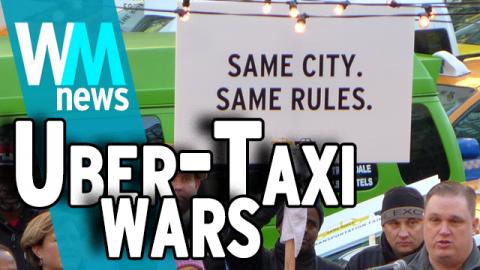Top 5 Need To Know Facts About The Uber-Taxi Wars

In the twenty-first century, the taxi industry is changing fast. It's now easier than ever to book a cab, or to become a cab driver. Welcome to WatchMojo News, the weekly series from WatchMojo.com where we break down news stories that might be on your radar. In this instalment, we're counting down 5 need to know facts about the ongoing war between Uber and traditional taxi companies.
#5: What Are the Uber and Taxi Wars?
The Situation
Founded in 2009, headquartered in San Francisco and operating in over 300 cities worldwide, Uber is one of the fastest growing and most successful digital start-ups of the 21st century. However, it has also been continually dogged by controversy, and was reportedly involved in about 173 lawsuits around the world as of late 2015. It’s being taken to court in cities across the globe by competitors (who argue that Uber represents unfair competition), by customers (some of which have experienced violent or sexual crime while using the service), and by its drivers (who are not officially recognised as ‘employees’ of the company). In general, there is growing opinion that Uber is not sufficiently regulated or controlled, despite the firm itself claiming otherwise.
#4: What Are the Key Battle Issues?
The Specifics
Protestors claim that drivers are not adequately vetted before they begin working for the company. Uber’s opposition says that background checks aren’t comprehensive enough, drivers aren’t properly trained, there are no significant examinations, and that there aren’t sufficient safety measures in place to stop an Uber driver from abusing or assaulting the customer. Cases of rape, sexual assault and general violence have worryingly risen as Uber has grown, and critics point out the vulnerable position that riders can find themselves in. Furthermore, for the honest and upstanding Uber driver, working for the ride-hailing app isn’t always a good thing either. One of the major points of contention with the company is that it does not recognise its drivers as ‘employees’, but rather as ‘contractors’. As a result, Uber drivers do not qualify for things like health insurance, overtime or other workers’ benefits. While Uber argues that this business model ensures flexibility for its drivers, the more cynical commentator says that it’s an exercise in tax avoidance and saving money.
#3: Which Countries Are Involved?
The Globe
Traditional taxi drivers have staged go slow demonstrations in London, and road blocks have been carried out in Paris, Warsaw, Sao Paulo and Melbourne (among other cities). The conventional cabbie is subject to much stricter checks, and is typically required to make heavy financial investment in order to obtain the relevant licences. But in the modern world, their investment is met with increasingly less clients, as more people choose to use Uber, and so protests have broken out on an international scale. Anti-Uber incidents grew increasingly more commonplace throughout 2015 in particular, and the rising bad publicity is encapsulated in the US. Uber’s problems in America began in May 2011, when it received a cease-and-desist letter from the San Francisco authorities. Since then, there have been multiple protests by taxi companies, as well as from within their own ranks – in 2015, Uber drivers in California mounted a class-action lawsuit against the company in a bid to be given more recognition.
#2: How Have Governments Reacted?
The Legislation
Various pieces of legislation have gradually crept in around the world. In Spain and Italy, the company is fully banned, as it is in other cities such as Brussels and Rio de Janeiro; in Australia, an Uber driver must be registered to collect the Goods and Services tax; in Vancouver in 2012, authorities slapped a $75 minimum fare onto Uber trips to allow for fairer competition with traditional taxis. London is also steadily moving toward harsher restrictions on Uber operations, and raids have been staged on Uber offices in Amsterdam as authorities try to determine whether the app breaks taxi laws. Two senior company executives were placed on trial in France in 2015, charged with ‘misleading commercial practices’ and ‘complicity in the illegal exercise of the taxi profession’. Each national situation is different, but there is an ongoing international movement to at least regulate Uber.
#1: Who Will Come Out on Top?
The Future
Clearly pressure is mounting on Uber, but it remains to difficult to see the company being beaten. The idea is both innovative and popular, which means that for all its problems, it will likely remain supported. But, Uber is very far from the finished article and it must surely adapt and make improvements if it is to remain successful. Concerns about safety will simply not go away until it begins to properly regulate its drivers, and issues relating to the lack of ‘employee status’ are set to continually bubble until a satisfactory resolution is found. For the traditional taxi firm however, the long-term outlook does not look good. To hail a cab from the side of the street has suddenly become an old-fashioned practice, out of touch with today’s impatient consumer. As much as Uber could do with mimicking some parts of the classic taxi model, older cabs need to incorporate some Uber-style technology into their service as well.
Did these facts get you thinking? To vote for which news story is covered next head over to WatchMojo.com/suggest, and be sure to hit that subscribe button.

